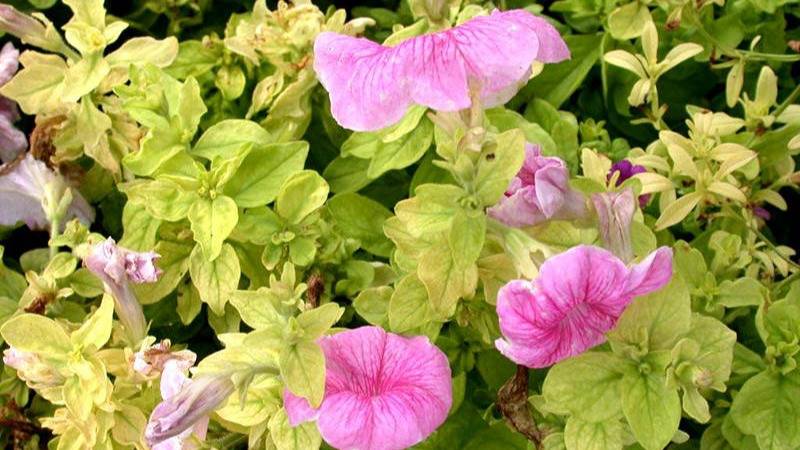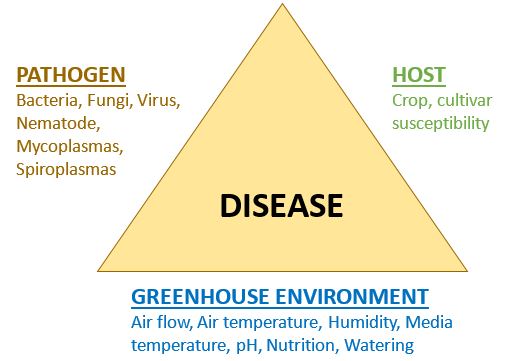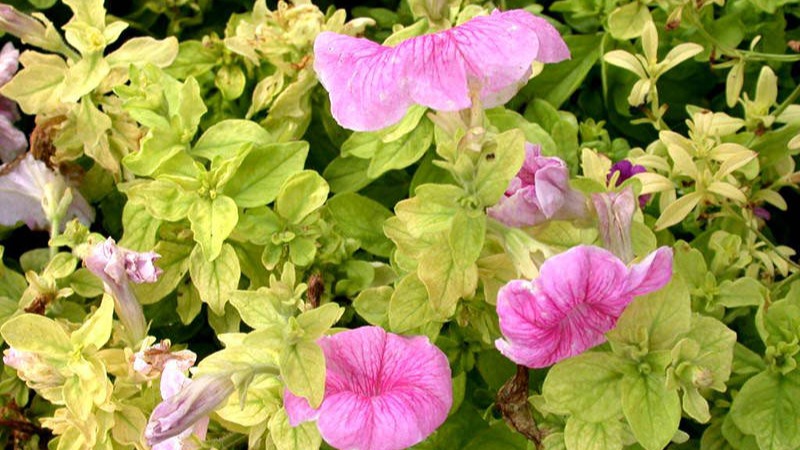Root Disease Triangle: Pathogens, Host and Environment


When growing greenhouse crops, it is simply a matter of time before problems occur. These problems can be caused by diseases, insects, fertility problems, pesticide phytotoxicities, plant growth regulator over-application, watering problems, air pollution from heaters, etc. To correct a problem, it is necessary to know what it is and what is causing it.
Similar looking symptoms
Unfortunately, many types of problems have similar-looking symptoms, so it is important to test a crop to determine the cause. However, what type of test do you do? If you send in a plant to be tested for disease when the problem is coming from a malfunctioning furnace, the source of the problem will not be identified. Therefore, it is best to start investigating the problem in the greenhouse, taking note of all the variables that could be causing a problem to narrow down the cause.
Disease Triangle
In the case of plant disease, certain conditions must be in place for a disease to occur. This is often simplified in a picture called the disease triangle (Figure 1). The disease triangle points out that three favorable conditions must coexist to cause a disease problem. These three conditions are the presence of a pathogen, a susceptible host (plant) and proper environmental conditions.

Pathogen
Several types of organisms cause plant diseases. These include fungi, bacteria, viruses, nematodes, mycoplasmas and spiroplasmas. These pathogens need to be present in the greenhouse to set the stage for a disease problem. Root disease pathogens can be introduced through plant debris, weeds growing under the bench, dust coming in from a field or gravel driveway, contaminated tools, stock plants, leftover plants, insects, etc.
Host
A host is a plant that can become infected by a pathogen. Not all plants are susceptible to attack from the same pathogen as some pathogens have a preference for certain plants. For example, Thielaviopsis typically attacks pansies, petunias, snapdragon, verbena, etc., but does not typically infect marigolds.
Within the same plant species, there can be differences in susceptibility to a specific pathogen. For example, calibrachoa that are compact and slow-growing often have more issues with root disease than faster-growing cultivars. Also, consider that within the same species of plants, some may have been bred to have resistance to certain pathogens.
If a grower encounters more disease problems with a type of plant, those are often removed from the production schedule due to higher fungicide application costs and plant loss. Also, when these plants have disease, they introduce more inoculum in the greenhouse, putting other crops at risk.
Environment
This is the most complex of the three conditions, but it can also be manipulated to reduce root disease issues. Any environment that causes plant stress can make a plant more susceptible to plant disease. The main factors to consider are as follows:
Watering
Watering is often the major concern when it comes to root disease problems. Pythium and Phytophthora are water molds and prefer a wet growing medium. Overwatering provides the best environment for these pathogens and also stresses plant roots, making them susceptible to attack. Fusarium, Rhizoctonia and Thielaviopsis also require moist media but do not need wet growing media to thrive. They often attack plants that are under stress, which can be triggered by overwatering.
Temperature
Some root disease pathogens, such as Pythium ultimum, prefer cooler growing medium temperatures, while Pythium aphanidermatum prefers warm growing media. The crop itself has a preferred temperature range and it becomes stressed and more susceptible to pathogen attack if it’s grown in a hotter or colder environment. For example, vinca prefers hot growing conditions. If growing medium temperatures are below 75°F or 24°C, they are more susceptible to root disease pathogens.
Air Movement
As with foliar diseases, poor air movement through the crop increases the potential for root disease. Humid air stays trapped in the plant canopy, thereby reducing plant water use from the growing medium. The growing medium dries out more slowly, making it easier to overwater. As a result, plants are stressed and susceptible to root disease pathogens.
Humidity
As with air movement, high humidity slows the dry down rate of the growing medium. It limits water usage by the plant and slows evaporation from the growing medium surface. If the growing medium dries out slowly, it increases plant stress and susceptibility to root disease pathogens.

Plant diseases can be problems for growers from time to time. As seen above, several factors must occur at the same time for root disease to start. If you have any questions, contact your Premier Tech Grower Services Representative or your Regional Sales Representative.